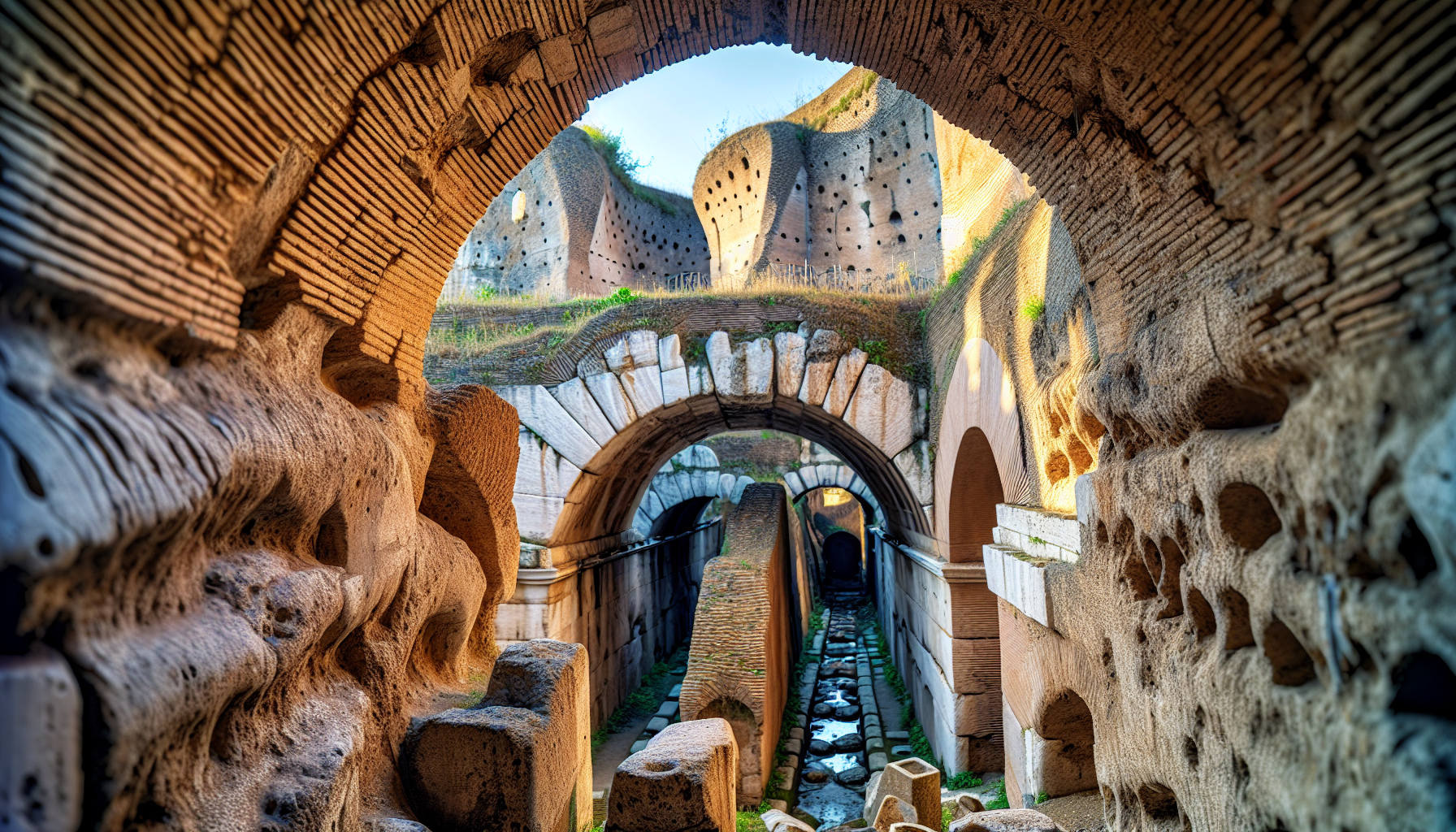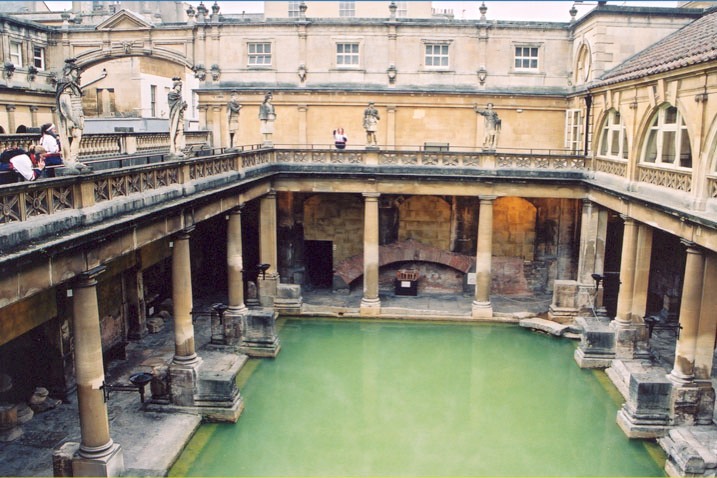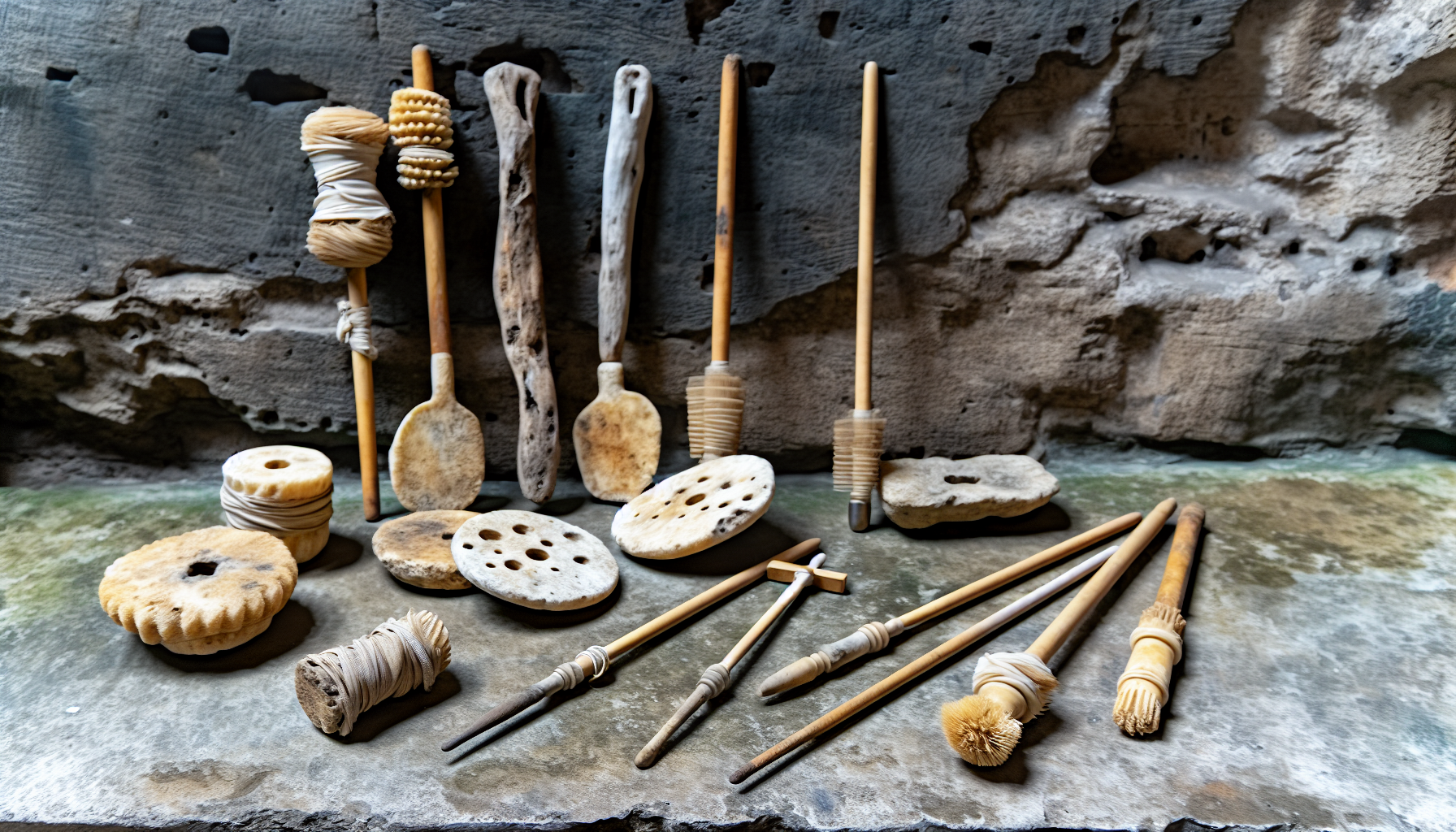Unveiling a world lost in time, we journey back to the zenith of the Roman Empire, where the public latrines and bathhouses were as much a testament to Roman engineering as they were crucibles of culture and social interaction. But what lay behind these grand structures? What secrets did the Roman bathrooms hold? Let’s journey through history to unravel the intricacies of the ancient Roman bathroom – a fascinating tale of innovation, hygiene, and social significance.
Key Takeaways
- Roman aqueducts provided clean water to Roman bathrooms and latrines, allowing them to be built on a grand scale.
- The Romans employed intricate water laws and quality control measures for their wealth of freshwater sources.
- Public latrines were communal toilets used in Ancient Rome as social gathering spots, while the elite utilized private toilets and chamber pots with opulent decoration.
The Role of Aqueducts in Roman Bathrooms

The magnificence of Roman baths and latrines highlights the impressive design of Roman aqueducts, a vital element of Roman sanitation. These architectural masterpieces, stretching across the Roman Empire, carried freshwater from springs, reservoirs, and rivers to every corner of the Roman city.
But how did they manage to cover such vast distances and maintain the water’s purity?
Fresh water sources
The Roman Empire, including Roman Italy, had a wealth of water sources, which were essential for almost every Roman city, ranging from:
- the springs in the Anio Valley
- reservoirs
- lakes
- rivers
The Romans, with their sharp scientific acumen, identified and accessed these freshwater sources, employing various methods from collecting water from springs to constructing aqueducts. Such was their dedication to water conservation that they even had intricate water laws to settle any disputes over water sources.
Nevertheless, not every water source was considered suitable for consumption. The Romans had a meticulous system of quality control, with water from clay soil areas deemed unsatisfactory. The Romans, with their innovative spirit, constructed channels and dams to divert clean rivers into distinct channels, ensuring a consistent flow of water to the aqueducts.
Distribution and maintenance
The Romans showcased their engineering skills in both obtaining water and distributing it. Their aqueducts were a marvel of design, exploiting gravity to carry water across the city. The materials used in the construction of these aqueducts varied based on location and available resources but typically included concrete, stone, and brick. Yet, the Roman engineers faced considerable challenges, such as identifying clean water sources and dealing with increasing demand.
Nevertheless, their innovative solutions helped overcome these challenges and ensured an efficient water distribution system. In fact, their commitment to maintenance and repair ensured the longevity of these aqueducts, contributing to the proper functioning of the Roman latrines.
Water quality management
Keeping a steady supply of fresh water was a challenging task. The Romans had to ensure the quality of water flowing through their aqueducts. This was achieved by sourcing water from clean springs and avoiding polluted sources. However, due to the complexity of the water supply system, contamination was inevitable. Lead pipes used to distribute water around the city often led to contamination.
Despite these issues, the Romans employed a variety of techniques to maintain water purity, such as regular cleaning and maintenance, the use of settling tanks, and the construction of filters and distribution systems.
The Sewage System of Ancient Rome

As we further investigate the complexities of the Roman bathroom, we come across the intricate design of the Roman sewage system. An integral part of the Roman sanitation infrastructure, the sewage system efficiently managed waste disposal, draining bathwater and swamp areas.
But what made these sewers so effective?
Terra cotta piping and concrete sealing
The terra cotta pipes were a key component in the efficiency of the Roman sewage system. These cylindrical tubes, formed from clay and fired in a kiln, were joined together using mortar or clay seals to create an intricate network of sewage pipes. With its smooth interior, Terra cotta facilitated the efficient flow of sewage, making it an ideal material for the job.
Yet, the Romans didn’t stop at just efficient piping. They employed concrete to line the sewage canals, preventing leaks and seepage, thereby ensuring the durability of their sanitation infrastructure.
The Cloaca Maxima
The Cloaca Maxima, the city’s largest sewer, was the centerpiece of the Roman sewage system, including the impressive Roman sewers. Constructed in the 4th century BC, the Cloaca Maxima revolutionized Rome’s sanitation system, providing an efficient means of waste disposal. This impressive structure drained local marshes and removed waste from the city, discharging it into the River Tiber.
The significance of the Tiber River in Rome’s sanitation cannot be overstated. While it was used for bathing and irrigation, it also served as a conduit for disease transmission, making the role of the Cloaca Maxima even more crucial.
Draining swamp areas and bathwater
The Romans went to great lengths to manage excess water, constructing drainage canals to facilitate the draining of swamp areas. This not only resulted in fertile farmland but also reduced the spread of diseases caused by stagnant water. The primary purpose of the Roman drainage system was to manage excess water rather than human waste.
The draining of swamp areas not only improved sanitation but also led to economic growth, urban development, and the support of various industries.
Public Latrines and Foricae: Communal Toilets in Ancient Rome

Moving away from the impressive aqueducts and complex sewage systems, we now turn to the core of Roman hygiene – the Roman public toilets. Known as foricae, these public latrines were far more than just a place for relief. They were social gathering spots, bustling with chatter and laughter in these communal toilets.
However, beneath the camaraderie, these latrines presented potential health risks.
Construction and locations
The construction of the public latrines was a testament to Roman engineering. Built over channels of flowing water, these latrines featured long benches with small holes cut into them, providing a place of relief for many Romans at once.
The strategic placement of these latrines in the heart of the city, near marketplaces or public squares, ensured convenient access for nearly all city dwellers.
Social interactions and etiquette
Public latrines were more than just places of hygiene; they were social hubs. Their communal nature allowed for interaction and conversation, making them a cornerstone of Roman social life. Etiquette was observed in these places, with communal sponges on sticks being used for cleaning oneself after using the latrine.
These sponges were shared among users and rinsed in a bucket of vinegar or salt water before and after use to ensure hygiene.
Health concerns and disease transmission
Despite their social significance, public latrines posed potential health risks. Diseases such as typhus and trench fever were commonly transmitted in these communal spaces due to the unsanitary conditions. The propagation of diseases was facilitated by the fecal-oral route, with the presence of parasites in the waste.
Despite the sanitation systems in place, such as latrines and sewer systems, they were not always effective in preventing health issues.
Private Toilets and Chamber Pots: Bathroom Practices of the Roman Elite

The narrative was different for the Roman elite. Far from the bustling public latrines, they enjoyed the luxury of private toilets and chamber pots, often nestled within opulent settings.
What was the appearance of these private toilets, and how did they differ from the public ones?
Private latrines and their separation from public sewers
Private latrines in Roman elite homes were a far cry from the public ones. These toilets were built over cesspools, away from the public sewers, and were emptied by hand by individuals known as stercorraii.
The design of these ancient latrines varied, with examples found in Roman houses and upstairs apartments in Pompeii and Herculaneum.
Use of chamber pots
In addition to private latrines, the Roman elite also utilized chamber pots. These were often ornately decorated and emptied by slaves.
Chamber pots were an integral part of Roman elite households, serving as portable toilets that could be easily disposed of.
Opulent settings and decoration
The private bathrooms of Roman elites were a visual treat. Adorned with:
- imported rugs
- marble walls
- marble sinks
- water basins
- sometimes heated floors
These Roman bathrooms, a reflection of the high societal status and the epitome of luxury in ancient Roman times, were commonly used by ancient Romans, who often admired the beauty of a Roman goddess.
Hygiene Practices and Tools in Roman Bathrooms

Roman bathrooms were not solely for infrastructure and social interactions; hygiene was also a significant aspect. Romans had specific hygiene practices and tools, from the shared sponges on sticks to the alternatives to toilet paper, all contributing to their cleanliness standards.
An interesting hygiene tool in Roman bathrooms was the shared sponge on a stick, known as the xylospongium. These shared sponges were used for personal hygiene after using the toilet. These sponges, despite being shared, were cleaned regularly to ensure hygiene. However, the use of shared sponges did pose potential health risks, such as the transmission of diseases like dysentery.
Alternatives to toilet paper
In Roman times, toilet paper as we understand it today, did not exist. Instead, Romans used the xylospongium, a sponge on a stick, as an alternative to toilet paper. This tool, which was soaked in either vinegar or salt water, was used for cleaning after using the restroom.
Bathing rituals and cleanliness standards
Maintaining cleanliness was a matter of pride for the Romans. They had specific bathing rituals and standards, which included:
- Daily visits to the public baths
- Usage of oils and soaps to clean their skin
- Use of tools like the ‘strigil’ to scrape dirt from their skin during bathing
The Cultural History and Significance of Roman Bathrooms
Roman bathrooms extended beyond mere hygiene facilities; they symbolized cultural values and displayed the time’s advanced infrastructure and city planning. The Roman toilet technology was innovative for its time and differed from that of the ancient Greeks.
Comparison with ancient Greeks
Comparing with the ancient Greeks offers a unique viewpoint on Roman bathroom practices. While the Greeks lacked public toilets and had different hygiene practices, both civilizations shared a common emphasis on cleanliness and public bathing.
Roman infrastructure and city planning
Roman bathrooms reflected the era’s advanced infrastructure and city planning. They played an integral role in city planning, with the Roman baths and latrines acting as a cornerstone of Roman infrastructure.
The evolution of toilet technology
Over time, Roman toilet technology transitioned from basic foricae to sophisticated private latrines. This evolution showcases the innovative spirit of the Romans and their continuous efforts to improve sanitation and hygiene in Roman bathrooms.
Summary
The ancient Roman bathroom, a testament to Roman engineering and a crucible of culture, provides fascinating insights into Roman life. From the grand aqueducts that supplied water to the city, the innovative sewage system that managed waste disposal, to the bustling public latrines and opulent private bathrooms, Roman hygiene practices were a remarkable blend of technology, architecture, and social interaction. As we journey back to the present, we are left inspired by the ingenuity and innovation of the Romans, their commitment to sanitation, and their unique blend of hygiene and social interaction in their, Roman bathrooms.
Frequently Asked Questions
What were Roman bathrooms called?
In Ancient Rome, the baths were known as “thermae” or “balneae,” and they were essential parts of daily life. They were designed to serve as places for bathing and exercise, often including heated rooms and pools.
How did Romans clean themselves?
The Romans used a combination of oil and a metal scraper called a strigil to clean themselves after bathing. They would rub the oil into their skin before scraping it off with the strigil, removing any remaining dirt or grime.
What did Romans usually wipe themselves with after going to the bathroom?
The Romans usually wiped themselves after going to the bathroom using a tool called a tersorium, consisting of a fresh sea sponge attached to a wooden rod dipped in clean flowing water.
What are the three types of Roman baths?
The three types of Roman baths were the caldarium (hot bath), tepidarium (lukewarm bath) and frigidarium (cold bath), which were all enclosed in a wooden barrel-vaulted building. Additionally, some thermae featured steam rooms like the sudatorium, laconicum, and dry hot room.
What kind of toilets did the Romans use?
The Romans used private toilets called latrina in Latin, which were typically constructed over a cesspit. Additionally, public toilets known as foricae were often attached to public baths and were flushed with bath water.
What are some fun facts about Roman bathroom houses?
Roman bathrooms were big buildings with swimming pools, changing rooms and toilets. They also had hot and cold rooms more like modern Turkish baths. The water in the Great Bath now is green and looks dirty. This is because tiny plants called algae grow in it.
Were Roman bathrooms unisex?
Were Roman bathrooms unisex?
The seats of the toilets at Roman bathrooms are close together. And there is little historical evidence that men and women had separate bathroom (or bathing) facilities. Some modicum of privacy was provided by the Roman’s loose togas, since they were hiked up rather than pulled down.
